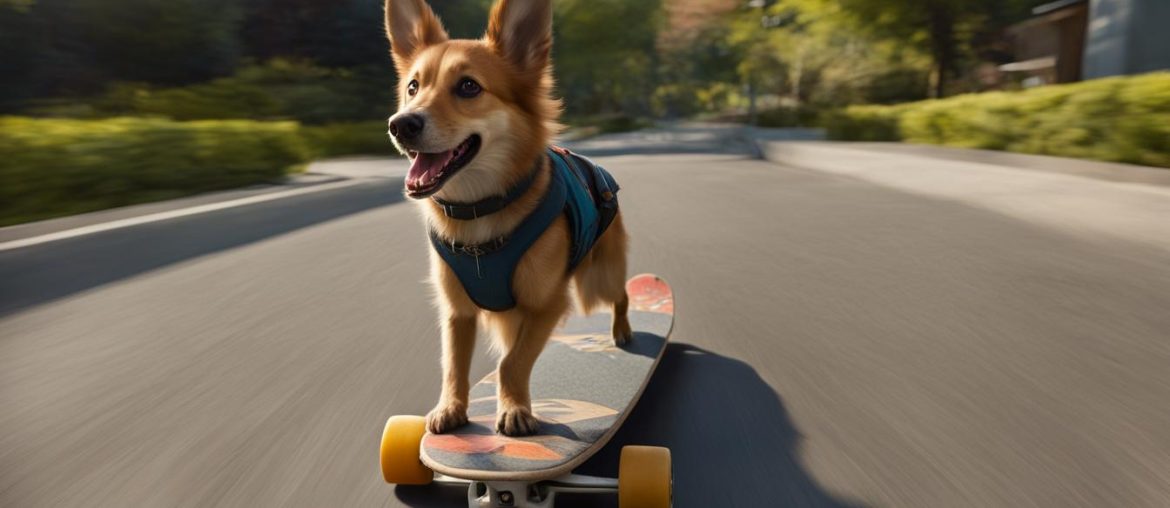Teaching your dog to skateboard can be a fun and engaging activity that strengthens the bond between you and your furry friend. However, approach this training process with careful consideration. Factors such as your dog’s breed, age, and athletic ability should be taken into account before starting skateboard training. Bulldogs and other muscular breeds are generally better suited for skateboarding, while dogs with short legs may face difficulties.
Before introducing your dog to the moving skateboard, please familiarize them with the stationary board. This can be done by allowing them to sniff, walk around, and even stand on the skateboard. Positive reinforcement through treats and praise will help create positive associations with the skateboard.
Once your dog is comfortable with the stationary skateboard, you can gradually introduce movement. Start by gently rocking the board and offering treats for your dog’s attention. As your dog becomes more confident, you can increase the distance and movement.
Safety precautions should always be taken when teaching your dog to skateboard. Use an appropriately sized skateboard for your dog’s comfort and practice in a safe, confined area. Regular supervision is essential to ensure your dog’s well-being.
Teaching your dog to skateboard not only provides mental stimulation but also serves as a great outlet for high-energy dogs. It’s a wonderful way to bond with your pet and enjoy a shared activity.
Key Takeaways:
- Consider your dog’s breed, age, and athletic ability before starting skateboard training.
- Familiarize your dog with the stationary skateboard using positive reinforcement.
- Gradually introduce movement and increase the distance over time.
- Take safety precautions and use an appropriately sized skateboard.
- Teaching your dog to skateboard provides mental stimulation and strengthens the bond between you and your dog.
Assessing Your Dog’s Abilities and Health
Before teaching your dog to skateboard, assess their breed, age, and athletic ability. These factors can impact their ability to learn and perform skateboarding tricks. Different breeds have varying levels of physical capability and aptitude for skateboarding. For example, breeds like Bulldogs and Jack Russells tend to pick up skateboarding more easily due to their muscular builds and high energy levels. On the other hand, dogs with short legs, like Welsh Corgis, may face challenges due to their inability to reach the ground from the skateboard.
Consulting with your vet is crucial to ensure that your dog is in good health and physically capable of handling the demands of skateboarding. They can assess your dog’s overall health, strength, and any potential limitations that may affect their ability to participate in this activity. I recommend that you prioritize your dog’s well-being and not push them beyond their physical capabilities.
Additionally, I would advise that you consider your dog’s individual personality and temperament. Dogs with a go-getter attitude and a willingness to approach new objects are generally more receptive to learning skateboarding. Shy or nervous dogs may require a different approach to training and may need additional time and patience to build their confidence around the skateboard.
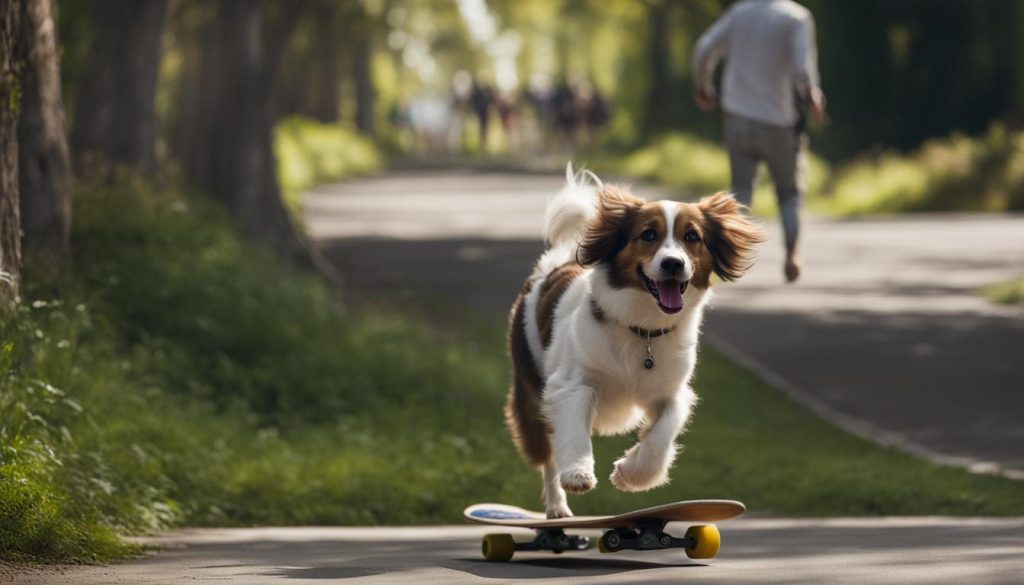
Assessing Your Dog’s Abilities and Health
| Breed | Age | Athletic Ability | Skateboarding | Dog’s Health |
|---|---|---|---|---|
| Bulldogs | Any age | High | Easier to learn | Consult with vet |
| Jack Russells | Any age | High | Easier to learn | Consult with vet |
| Welsh Corgis | Any age | Medium | May face challenges | Consult with vet |
By assessing your dog’s breed, age, athletic ability, and overall health, you can make an informed decision about whether skateboarding is a suitable activity for them. You should also prioritize their safety and well-being throughout the training process.
Familiarizing Your Dog with the Skateboard
Before introducing the moving skateboard, familiarize your dog with the stationary board through positive reinforcement. Start by allowing your dog to sniff, walk around, and even stand on the stationary skateboard. Offer plenty of treats and praise to create positive associations with the skateboard. This will help your dog feel more comfortable and confident around the board. Gradually increase the exposure to movement by gently rocking the skateboard while offering treats for attention. I recommend that you take this process slowly and let your dog set the pace. Use high-value treats like hot dogs, cheese, or boiled chicken to reinforce the desired behavior of being on the skateboard. Break up the training sessions over a couple of days and be patient with your dog’s progress.
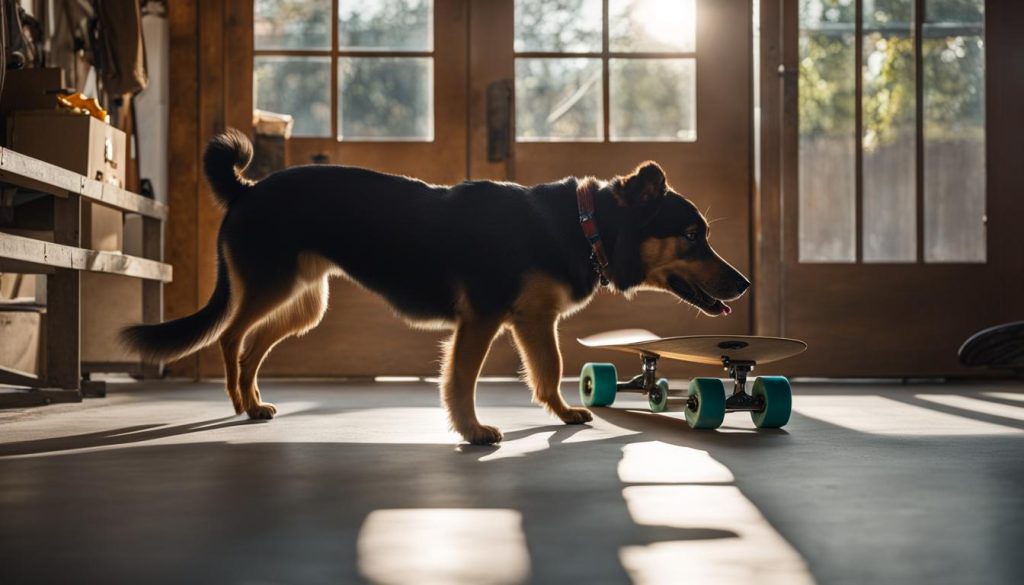
Table: Steps to Familiarize Your Dog with the Skateboard
| Step | Description |
|---|---|
| Step 1 | Allow your dog to sniff, walk around, and stand on the stationary skateboard |
| Step 2 | Gently rock the skateboard while offering treats for attention |
| Step 3 | Gradually increase exposure to movement |
| Step 4 | Use high-value treats to reinforce desired behavior |
| Step 5 | Break up training sessions and be patient with your dog’s progress |
Familiarizing your dog with the skateboard is an essential step in the training process. By creating positive associations and gradually introducing movement, you can help your dog feel more comfortable and confident on the skateboard. Using high-value treats and allowing your dog to set the pace will ensure a successful and enjoyable training experience.
Starting with a Stationary Skateboard
Now that your dog is familiar with the skateboard and has built up some positive associations, it’s time to start with a stationary skateboard. This step is crucial for building your dog’s confidence and getting them comfortable with the muscle memory required to step up onto the board. Place the skateboard on a grassy or carpeted surface to stabilize it or lock the wheels to prevent movement. The goal is to have your dog get used to the sensation of being on the skateboard and gradually progress to more dynamic movements.
To start, stand behind the skateboard with a treat in your hand and guide your dog towards it. Encourage them to step onto the skateboard and reward them with praise and treats for being on it. Take it slow and allow your dog to work at their own pace. Some dogs may take longer to feel comfortable stepping onto the skateboard, so be patient and give them breaks when needed.
Try to use high-value treats to reward your dog for staying still on the skateboard. This will help reinforce the behavior and create a positive association with being on the board. Over time, your dog will become more confident and comfortable with the stationary skateboard, setting the foundation for the next steps in the training process.
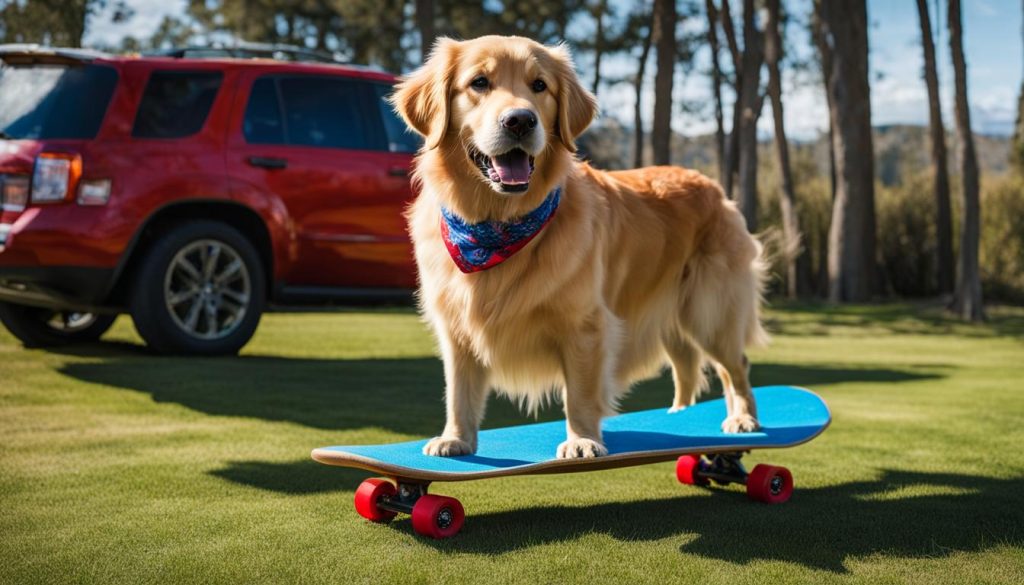
Table: Step-by-Step Guide to Starting with a Stationary Skateboard
| Step | Action |
|---|---|
| 1 | Place the skateboard on a stable surface. |
| 2 | Stand behind the skateboard with a treat in your hand. |
| 3 | Guide your dog towards the skateboard, encouraging them to step onto it. |
| 4 | Reward your dog with praise and treats for being on the skateboard. |
| 5 | Take it slow and allow your dog to set the pace. |
| 6 | Use high-value treats to reinforce the behavior of staying on the skateboard. |
| 7 | Be patient and give your dog breaks when needed. |
Gradually Introducing Movement
Once your dog is comfortable with the stationary skateboard, it’s time to gradually introduce movement. This step is crucial in the training process, as it helps your dog become accustomed to the feeling and motion of a moving skateboard. Start by loosening the wheels of the skateboard slightly, allowing for slow and controlled movement. However, keep the trucks tight to prevent excessive wobbling and instability.
To begin, gently move the skateboard while your dog is on it, maintaining a steady pace. Reinforce your dog’s behavior with praise and treats for staying on the board. You should also take this step slowly and repeat it until your dog feels comfortable with the movement. To put it simply, if your dog jumps off the skateboard, don’t worry—it’s part of the learning process. The key is to create a positive and rewarding experience for your dog throughout the training sessions.
During this phase, provide continuous positive reinforcement. Use treats and praise to reward your dog for staying on the skateboard while it’s in motion. This will help your dog associate the movement with positive experiences, making the learning process more enjoyable and effective. Be patient and allow your dog to progress at their own pace, gradually increasing the distance and speed of the skateboard movement as they become more confident.
Benefits of Gradual Introduction
Gradually introducing movement to your dog’s skateboard training has several benefits. Firstly, it allows your dog to build trust and confidence in their ability to balance and stay on the board while it’s in motion. This helps enhance their overall skateboarding skills and sense of coordination. Secondly, the gradual approach helps prevent any fear or anxiety that your dog may associate with sudden movements. By slowly increasing the speed and distance, your dog can comfortably adapt to the motion and build their skateboarding skills over time.
| Benefits of Gradual Introduction | |
|---|---|
| 1. Improved balance and coordination | Gradually introducing movement helps your dog develop better balance and coordination skills while on the skateboard. |
| 2. Reduced fear and anxiety | The gradual approach helps your dog feel more comfortable and less fearful of the moving skateboard, preventing any anxiety that may hinder their progress. |
| 3. Enhanced skateboarding skills | By starting with slow and controlled movements, your dog can gradually build their skateboarding skills, improving their overall performance. |
Try to always prioritize your dog’s well-being and safety during the training process. Make sure to engage in regular exercise and warm-up activities to prevent any injuries or strain. With patience, consistency, and positive reinforcement, your dog will master the art of skateboarding in no time!
Teaching Your Dog to Move the Skateboard
Once your dog is comfortable with the stationary skateboard, you can start teaching them how to move it. One effective way to do this is by attaching a leash or rope to the skateboard for better control. With your dog’s front paws on the skateboard, gently move the board from side to side using your foot or hand. This helps your dog learn how to shift their weight and move with the skateboard. Gradually increase the distance of movement, reinforcing the behavior with treats and praise.
Your dog will eventually understand that moving their back feet or front foot will make the skateboard move towards the treat or reward. This step requires patience and consistency to help your dog establish the connection between their actions and the skateboard’s movement. Always ensure that your dog feels safe and comfortable during the training process, and never force them onto the skateboard if they’re not ready.
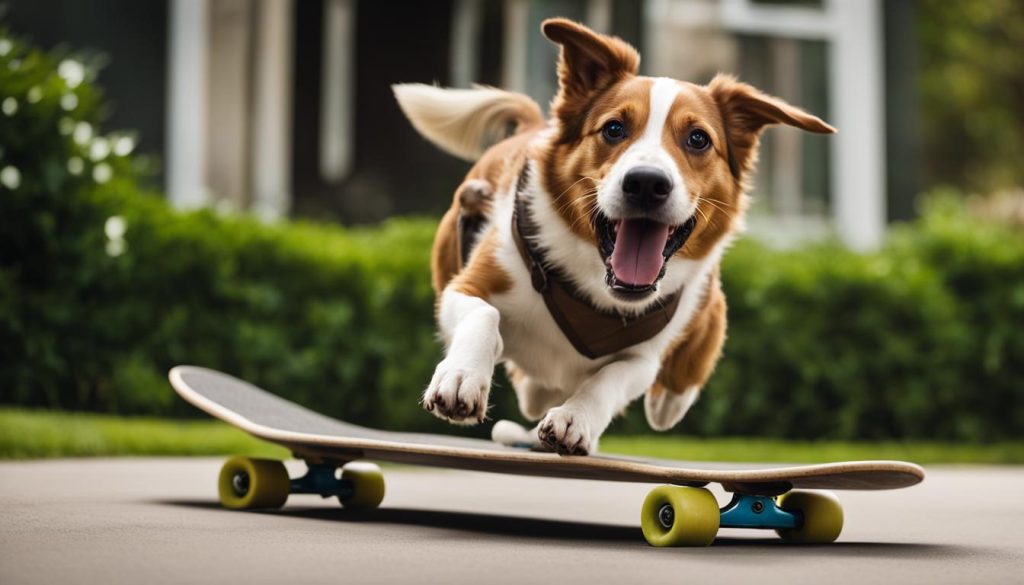
Moving the Skateboard: Training Tips
When teaching your dog to move the skateboard, remember to:
- Use positive reinforcement techniques such as treats, praise, and toys to motivate your dog.
- Take breaks during training sessions to prevent frustration or fatigue for both you and your dog.
- Be patient and work at your dog’s pace, as every dog learns differently.
- Celebrate small wins and progress along the way to keep your dog motivated.
| Tips for Teaching Your Dog to Move the Skateboard |
|---|
| Use positive reinforcement techniques |
| Take breaks during training sessions |
| Be patient and work at your dog’s pace |
| Celebrate small wins and progress |
Safety Precautions When Teaching Your Dog to Skateboard
When embarking on the journey of teaching your dog to skateboard, it is essential to prioritize their safety. By following these key safety precautions, you can create a secure environment for both you and your furry friend:
- Choose the right skateboard size: You should select a skateboard that is appropriate for your dog’s size. Ensure that they can comfortably stand with all four paws on the board. Avoid using skateboards that are smaller than 10.5 inches in width, as they may not provide enough stability for your dog.
- Create a safe training area: Designate a secure and confined area for training sessions. Start indoors or in a fenced-in yard before progressing to more open spaces like a driveway or park. This will help prevent accidents and provide a controlled environment for learning.
- Pad protection: Take care of your dog’s paw pads. The motion of pushing the skateboard can cause discomfort for dogs with soft pads. Regularly check your dog’s paws to ensure they are not getting injured or irritated during training sessions. Consider using paw wax or protective boots to provide extra cushioning and prevent any potential injuries.
- Supervision is key: Always supervise your dog when they are on the skateboard. Maintain control of the skateboard at all times to prevent your dog from getting into dangerous situations. By closely monitoring their progress, you can intervene if needed and ensure a safe training experience.
By following these safety precautions, you can minimize the risk of accidents and injuries while teaching your dog to skateboard. To put it simply, safety comes first, so take the necessary steps to protect your four-legged companion throughout their skateboarding journey!
| Safety Precautions | Importance |
|---|---|
| Choosing the right skateboard size | Provides stability and comfort for your dog |
| Creating a safe training area | Prevents accidents and provides a controlled environment |
| Pad protection | Ensures your dog’s paw pads are not injured or irritated |
| Supervision is key | Allows you to intervene and prevent dangerous situations |
To put it simply, safety should always be a top priority when teaching your dog new tricks or activities. Take the necessary precautions, provide a safe training environment, and enjoy the process of watching your furry friend become a skateboarding pro!
The Benefits of Teaching Your Dog to Skateboard
Teaching your dog to skateboard offers numerous benefits that go beyond just a fun trick. One of the key advantages is the mental stimulation it provides. As your dog learns new skills and problem-solving abilities, their cognitive abilities are challenged and exercised. This mental stimulation can help prevent boredom and destructive behavior.
In addition to mental exercise, teaching your dog to skateboard also provides physical exercise. Skateboarding requires coordination, balance, and muscle strength, which promotes overall fitness for your furry friend. It’s a great way to release pent-up energy and keep your dog physically active.
Another significant benefit of teaching your dog to skateboard is the bonding experience it creates. Through training sessions, you and your dog develop a deeper connection as you work together towards a common goal. This shared activity strengthens the bond of trust and reinforces the communication between you and your pet.
Table: Benefits of Teaching Your Dog to Skateboard
| Benefit | Description |
|---|---|
| Mental Stimulation | Teaching your dog new skills and problem-solving abilities |
| Physical Exercise | Promoting overall fitness, coordination, balance, and muscle strength |
| Bonding Experience | Strengthening the bond of trust and communication between you and your pet |
Overall, teaching your dog to skateboard is a rewarding experience that provides mental stimulation, physical exercise, and a stronger bond between you and your furry friend. Enjoy the journey of training and celebrate the progress as you watch your dog develop new skills and confidence.
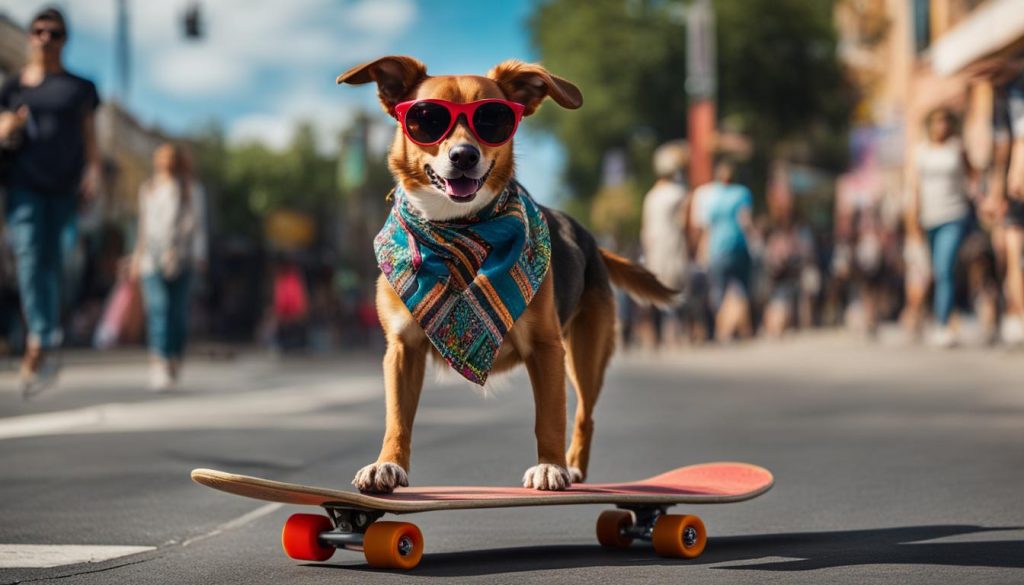
“Teaching your dog to skateboard is not only a fun trick, but it also has numerous physical and mental benefits for your furry friend. It’s a great way to keep them physically active, mentally stimulated, and strengthen the bond between you and your pet.” – Professional Dog Trainer
How to Train Your Dog to Skateboard: Expert Tips
Training your dog to skateboard requires patience, consistency, and the use of effective techniques. Here are some expert tips to help you successfully teach your dog this fun trick:
- Use Positive Reinforcement: Positive reinforcement is key when training your dog. Reward desired behaviors with treats, praise, and toys to motivate your dog and reinforce their successful attempts at skateboarding.
- Take Breaks: Training sessions can be tiring for both you and your dog. Take breaks to prevent frustration and fatigue. This will ensure that both you and your dog stay engaged and enjoy the training process.
- Work at Your Dog’s Pace: Every dog learns differently, so be patient and work at your dog’s pace. Celebrate small wins and progress along the way, and never force your dog onto the skateboard if they’re not comfortable.
To put it simply, training your dog to skateboard should be a fun and enjoyable experience for both of you. By using positive reinforcement, taking breaks, and being patient, you can successfully teach your dog this impressive trick. Happy skateboarding!

Expert Tip: Be Creative with Rewards
When using positive reinforcement, be creative with the rewards you offer your dog. Experiment with different treats, toys, or even playtime as a reward for successful skateboarding attempts. This will keep your dog engaged and excited to continue learning.
By following these expert tips, you can create a positive and effective training experience for your dog. Positive reinforcement, breaks, and working at your dog’s pace are essential techniques for teaching your dog to skateboard. Enjoy the process and celebrate the progress your dog makes along the way.
Final Thoughts
Teaching your dog to skateboard is an exciting and rewarding adventure that strengthens the bond between you and your furry companion. Through proper training techniques and consistent patience, any dog can learn this fun trick.
Before starting the training process, assess your dog’s breed, age, and athletic ability to ensure they are physically capable of skateboarding. Familiarize your dog with the stationary skateboard, gradually introduce movement, and teach them how to move the skateboard with their paws. Safety precautions, such as using an appropriately sized skateboard and creating a safe training area, are crucial.
Aside from the trick itself, teaching your dog to skateboard offers numerous benefits. It provides mental stimulation, physical exercise, and an opportunity for you and your dog to bond and enjoy a shared activity. Try to use positive reinforcement, take breaks when needed, and celebrate the progress made by your furry friend throughout the training journey.
So, grab your skateboard, gather some tasty treats, and embark on this rewarding adventure of teaching your dog to skateboard. Enjoy the process, celebrate the small wins, and strengthen the special connection you have with your four-legged companion.
FAQ
Can any dog learn how to skateboard?
Technically, any dog can learn how to skateboard, but certain breeds may catch on more easily than others.
What breeds are better equipped for skateboarding?
Breeds like Bulldogs and Jack Russells tend to catch on more easily to skateboarding.
Will dogs with short legs be able to skateboard?
Dogs with short legs, like Welsh Corgis, may struggle due to their inability to reach the ground from the board.
Is it important to consult with a vet before teaching a dog to skateboard?
Yes, consult with your vet to ensure your dog is physically fit for skateboarding.
What are some important qualities in a dog for learning skateboarding?
Dogs with a go-getter attitude and a willingness to approach new objects tend to find learning skateboarding easier.
How should I familiarize my dog with the skateboard?
Start by letting your dog sniff, walk around, and even stand on the stationary skateboard. Associate it with positive experiences through treats and praise.
How do I start training with a stationary skateboard?
Place the stationary skateboard on grass or carpet and guide your dog to step onto it. Use treats and praise to reward and encourage them to stay on the board.
How do I introduce movement to the skateboard?
Gradually rock the skateboard while your dog is on it, reinforcing the behavior with treats and praise for staying on the board.
How can I teach my dog to move the skateboard?
Attach a leash or rope to the board for better control and gently move the skateboard while your dog is on it. Use treats and praise to reinforce the behavior.
What safety precautions should I take when training my dog to skateboard?
Use an appropriately sized skateboard, practice in a safe, confined area, supervise your dog at all times, and regularly check their paw pads for any injuries or irritation.
What are the benefits of teaching your dog to skateboard?
Teaching your dog to skateboard provides mental stimulation, physical exercise, and strengthens the bond between you and your furry friend.
What are some expert tips for training a dog to skateboard?
Use positive reinforcement techniques, take breaks during training sessions, be patient with your dog’s progress, and make the experience fun and enjoyable for both of you.


